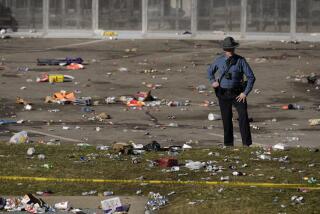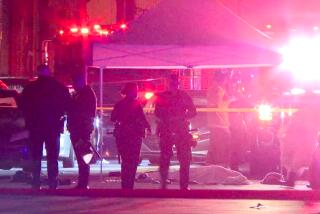Organizers ‘embarrassed’ by New Orleans parade shooting
When at least one man stepped into a New Orleans parade crowd on Mother’s Day and opened fire, 19 people were shot and injured — and a city’s conscience was also wounded.
Officials have not named or arrested any of the three suspects sought in the Sunday shooting, which left three people hospitalized in critical condition Monday.
A still-frame video of the shooting released by police showed one young man in a white T-shirt stepping into the crowd and opening fire, but it’s not known at whom or why.
Local officials, journalists and community organizers moved swiftly to condemn the violence and to separate the shooters from the city’s culture of “second-line” marches, a New Orleans tradition where residents walk the streets behind a band or other honorees.
“It’s the brazenness of [a shooting at] a second-line parade,” New Orleans Police Supt. Ronal W. Serpas told reporters at a Monday news conference, adding, “Second lines are an amazing part of our culture, and we support them.”
Addressing the unnamed suspect in the video, Serpas said, “We know a lot more about you than you think we do,” and urged him to turn himself in to police.
Other second-line marches have been marred by shootings, giving pause to many local voices who talked about how two disparate New Orleans cultures have collided: the joy of second lines and the sorrow of the city’s pervasive gun violence, among the worst in the nation.
“Today’s shooting was in no way a product of second-line culture or somehow set in motion by the parade or its route, as some critics may suggest,” the Mother’s Day second-line organizers, the Original Big 7 Social Aid and Pleasure Club, said in a statement. “Our parade brings together different folks from across the city — black, white, Latino, the young and the old, and lots of families — to celebrate the best of New Orleans.
“We feel embarrassed that the world is now viewing our city and our community through a lens of violence.”
One of the seven women shot in the march was Deborah “Big Red” Cotton, a journalist who has covered second lines and has written about violence at second lines before, which she thought brought unfair criticism on the city’s marches.
“What kind of monster opens fire on a Mother’s Day parade crowd? What kind of animal?” writer Brentin Mock blogged after visiting Cotton in the hospital; Cotton had been shot in the back and was sedated. “I hate myself for thinking to ask this in these exact terms, but it’s these exact terms in which I’m thinking.”
Many commentators took note of FBI spokeswoman Mary Beth Romig’s comment to the Associated Press on Sunday that the shooting did not appear to be terrorism, but “strictly an act of street violence in New Orleans.”
In a Sunday email with the Los Angeles Times, Romig didn’t mention terrorism: “It is a matter for the local police department. We were aware of the incident but quickly assessed it was not a federal matter.”
Ariella Cohen, a friend of Cotton’s, was troubled by the terrorism/street crime distinction.
“Die from street violence and you may be remembered by a wooden cross and a few teddy bears set to rest on the sidewalk by your neighbors. You may get a T-shirt printed with your name,” Cohen wrote in NextCity. “Die in a terror attack and there will be stone, marble and speeches to remember you with. ... We tell the stories of terror differently than those of urban violence.”
ALSO:
U.S. soldier guilty of premeditated murder
Abortion doctor guilty of killing 3 babies said to be born alive
More to Read
Start your day right
Sign up for Essential California for news, features and recommendations from the L.A. Times and beyond in your inbox six days a week.
You may occasionally receive promotional content from the Los Angeles Times.







